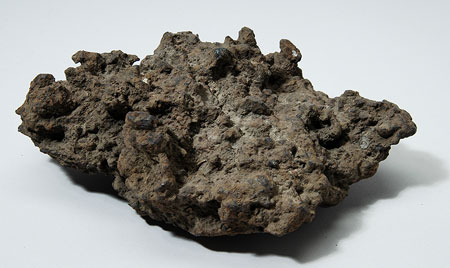Accession Number:
1979.20.25
Country:
Sudan
Region:
[Southern Sudan] Western Equatoria ?Lui ?Lanyi
Cultural Group:
Moru Misa
Date Made:
By 1979
Materials:
Mineral , Iron Ore Metal
Dimensions:
L = 250, W = 190, th = 74 mm [RTS 3/11/2004].
Weight:
4800 g
Other Owners:
Purchased by Patti Langton for £5 between 27th January and 5th February 1979 as part of the British Institute in Eastern Africa's Expedition to the Southern Sudan [RTS 15/6/2004].
Field Collector:
Patti Langton
PRM Source:
Patti Langton
Acquired:
Purchased 1979
Collected Date:
Between 27 January and 5 February 1979
Description:
Heavy piece of magnetic, reddish brown iron ore (Pantone 4705C), used for smelting.
This is almost square in plan view, but very irregular in form, with the surface made up of various projecting nodules, depressions and crevices, although the underside appears flatter and more regular, with fewer surface interruptions.
It is complete and intact, with small patches of surface dirt and vegetation adhering.
It is 250 mm long, 190 mm wide and 74 mm thick, and has a weight of 4800 grams.
Purchased by Patti Langton for £5 between 27th January and 5th February 1979 as part of the British Institute in Eastern Africa's Expedition to the Southern Sudan. The provenance was not recorded, but the expedition was collecting Moru material during this period from the settlements of Lui and Lanyi.
The shape of this piece of ore, its unworked state, the flattened base, and the fact that it does not have any broken edges where it has been split off from a larger object suggest that it is probably a nodule of naturally occurring volcanic ore that was picked up from the surface, rather than mined. It would have been collected for future smelting. Langton did not record its Moru name.
Rachael Sparks 6/9/2005.
Purchased by Patti Langton for £5 between 27th January and 5th February 1979 as part of the British Institute in Eastern Africa's Expedition to the Southern Sudan. The provenance was not recorded, but the expedition was collecting Moru material during this period from the settlements of Lui and Lanyi.
The shape of this piece of ore, its unworked state, the flattened base, and the fact that it does not have any broken edges where it has been split off from a larger object suggest that it is probably a nodule of naturally occurring volcanic ore that was picked up from the surface, rather than mined. It would have been collected for future smelting. Langton did not record its Moru name.
Rachael Sparks 6/9/2005.
Primary Documentation:
Accession Book Entry
[p.
185] - 1979.20 (.1 - 206) P[urchase] MISS PATTI LANGTON, DEPT.
of ETHNOLOGY & PREHISTORY, OXFORD.
Collection made by Patti Langton during the British Institute in East Africa's expedition to the Southern Sudan; Jan.
- April 1979.
The collection was made in three culture areas during the dry season.
The amount paid for each object is listed if the information is known.
In Jan.
1979 £1 is equivalent to 95 piastres (pt.) Sudanese.
This documentation is based largely upon Patti's own list of objects and her notes on these.
Sometimes objects included in the Pitt Rivers alottment of the collection do not appear on her list and have been added here.
See Related Documents file as well.
[pp 185 - 186] 1979.20.1 - 42 SOUTHERN SUDAN the MORU MISA The Moru Misa live about 100 miles west of Juba, the capital of the Southern Sudan.
Part of the collection was made in Lui, a small town which has had extensive church and missionary activity over the past 50 years (excluding the period of civil war) and which now boasts a church, a hospital and a number of schools.
The rest of the Moru Misa collection was made at Lanyi, 15 miles away, where the paramount chief of the area, Chief Elinama, arranged for people to bring artifacts for us to buy.
Although money is known to the Moru, its use is limited and the concept of selling belongings is foreign to them.
Hence the low prices and the relatively small number of artefacts.
The Moru Misa are a geographical section of the Moru people.
The Moru practice agriculture for subsistence; they do not keep cattle any longer.
[p.
189] 1979.20.25 - Piece of iron ore for smelting.
Max.
L = 26 cm; Cost £5.
Coll.
no.
61.
Additional Accession Book Entry [in red biro over accession number] - A5-F32-8.
Card Catalogue Entry - There is no further information on the tribes catalogue card [RTS 2/6/2004].
Related Documents File - 1979.20 contains a typed packing list, which has been annotated; a typed list of objects arranged by Langton collection numbers and with pencil and biro annotations, and a handwritten list of objects by museum number, essentially repeating this information and annotated with PRM photo numbers in red. This handwritten list seems to be the direct source for the accession book entry. This object appears on Langton's list as a pencilled addition [RTS 12/1/2004].
Additional Accession Book Entry [in red biro over accession number] - A5-F32-8.
Card Catalogue Entry - There is no further information on the tribes catalogue card [RTS 2/6/2004].
Related Documents File - 1979.20 contains a typed packing list, which has been annotated; a typed list of objects arranged by Langton collection numbers and with pencil and biro annotations, and a handwritten list of objects by museum number, essentially repeating this information and annotated with PRM photo numbers in red. This handwritten list seems to be the direct source for the accession book entry. This object appears on Langton's list as a pencilled addition [RTS 12/1/2004].





